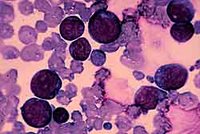Previous Posts
- Memories
- "Song For A Friend"
- Drain the veins in my headClean out the reds in my...
- Death Notice....Dropping like flies...
- Is that tear, I hear?
- Jason Mraz
- It's all right... it's okay...
- Almost Doesn't Count
- I lite the wick tonite, and walk away without turn...
- Never thought I'd be thinking about you... Listeni...
Archives
- 12/2004
- 01/2005
- 02/2005
- 03/2005
- 04/2005
- 05/2005
- 07/2005
- 08/2005
- 10/2005
- 11/2005
- 01/2006
- 02/2006
- 04/2006
- 06/2006
- 07/2006
- 08/2006
- 09/2006
- 10/2006
- 12/2006
- 01/2007
- 03/2007
- 04/2007
- 05/2007
- 07/2007
- 08/2007
- 09/2007
- 10/2007
- 12/2007
- 01/2008
- 02/2008
- 03/2008
- 04/2008
- 05/2008
- 09/2008
- 01/2009
- 06/2009
Links
Powered for Blogger
by Blogger templates
Just Di
Sunday, January 1


Vaccine Produces Leukemia Remissions
Peptide Directs Cells to Kill Cancer, Spare Normal Cells
Scientists have developed a vaccine that can produce a complete molecular remission in some myeloid leukemia patients, according to recent study results.
The vaccine is made from the PR1 peptide, a small part of a protein found on the inside of leukemia cells. The vaccine produced an immune response against cancer in 60% of patients tested (20 of 33 patients), according to the study conducted at M. D. Anderson and presented recently at the annual meeting of the American Society of Hematology.
Vaccine shows molecular remission
“These are very promising results in a group of patients who were quite sick, and who normally would live for just months,” says the study’s lead investigator Jeffrey Molldrem, M.D., an associate professor in the Department of Blood and Marrow Transplantation at M. D. Anderson.
Of the 20 patients who had an immune response:
Fourteen had an overall survival of four years
Three are in “molecular remission” in which there is no evidence of remaining disease
“Not only can we say that some of these patients had an immune response, but they also went into remission, and that has never been demonstrated to occur after peptide vaccination before for people with leukemia,” Molldrem says. “And for patients who showed an immune response but did not go into remission, progression of their cancer was slowed down compared to patients who did not have an immune response to the vaccine. Of course, we have much more research to do, especially in testing greater numbers of patients within each disease group.”
Nearly all of these patients had either:
Active or relapsed acute myelogenous leukemia (AML)
Refractory chronic myelogenous leukemia (CML), in which there is a dangerous accumulation of immature cells in the bone marrow
High-risk myelodysplastic syndrome (MDS), a precancerous bone marrow disorder
Delivery of the vaccine stimulates immune cells that recognize the PR1 peptide, which are recruited to the bone marrow, Molldrem says. The PR1 peptide directs immune T-cells to kill the leukemia and leave normal cells alone, he says.
Like many vaccines used to induce immunity against infections, this one appears to create an immune system “memory” for the PR1 peptide, meaning long-lasting protection. “Patients only get the vaccine three times, yet we have been able to measure an immune response in patients four years after treatment,” Molldrem says.